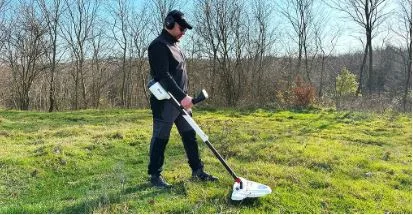The Revival of Gold Hunting: Modern Adventures with a Metal Detector
The Timeless Appeal of Gold Hunting
For centuries, the pursuit of gold has captivated adventurers, hobbyists, and entrepreneurs alike. In recent years, a fascinating trend has emerged—metal detecting for gold is regaining popularity. Once associated with retired treasure hunters or weekend hobbyists, gold detecting is now attracting a new generation of enthusiasts. Whether it’s the allure of striking it rich or simply enjoying the outdoors with a purpose, the modern resurgence of this activity reflects more than just nostalgia.
A blend of technology, community, and a renewed appreciation for analog adventures has turned gold detector use into a passion project for many. And in an increasingly digital world, the tactile excitement of hearing a real beep over buried metal feels refreshingly authentic.
Modern Technology Makes It Easier Than Ever
One of the main drivers behind the comeback is the rapid advancement in metal detector technology. Today’s devices are far more sensitive, lightweight, and accurate than their predecessors. Modern gold detector models can differentiate between metals, detect smaller nuggets, and reach deeper into the ground.
Manufacturers now produce specialized detectors designed exclusively for gold prospecting. These machines use pulse induction (PI) or high-frequency VLF (very low frequency) technologies, which allow users to identify gold in highly mineralized soils—traditionally a major challenge in the past.
Key improvements include:
- Enhanced sensitivity to small gold pieces
- Lightweight, ergonomic designs for easier handling
- Longer battery life for extended use
- User-friendly interfaces suitable for beginners
These features have removed much of the technical barrier that once kept people from trying their luck with a metal detector.
A Social Movement Fueled by Online Communities
Another reason metal detecting is back in the spotlight is the power of social media and online forums. Video platforms, discussion threads, and social groups now serve as digital gathering spaces for thousands of enthusiasts. These platforms not only provide tutorials and success stories, but they also create a sense of camaraderie.
People from around the world share footage of their finds, whether it’s a tiny gold flake or a centuries-old coin. These virtual campfires have encouraged more people to invest in a quality gold detector and explore their local areas. What was once a solitary activity has transformed into a global, connected hobby.
In addition to communities, some hobbyists have turned metal detecting into full-blown content creation journeys. This visibility has sparked curiosity and encouraged newcomers to consider it not just as a hobby, but as a lifestyle.
Economic Uncertainty Revives Interest in Precious Metals
In times of financial instability, people often turn to tangible assets like gold. The past few years have seen significant fluctuations in global economies, pushing individuals to explore alternative ways to invest or even earn extra income. Enter the metal detector.
While few people strike it rich, the prospect of supplementing income by finding gold adds an appealing edge to the hobby. The cost of a decent gold detector has also become more accessible, making the initial investment less intimidating. For those living near historically gold-rich regions, this can become a genuine side hustle.
Moreover, many hobbyists report that the mental and emotional benefits—spending time in nature, the thrill of the hunt, and the satisfaction of self-reliance—are just as rewarding as any actual find.
Environmental and Recreational Benefits
Unlike many forms of resource extraction, metal detecting—when done responsibly—is relatively low impact. It encourages outdoor activity, historical curiosity, and a sense of environmental stewardship. Enthusiasts often clean up trash they detect alongside potential treasures, inadvertently aiding in local conservation efforts.
Some families have also adopted metal detecting as a weekend activity. It provides a hands-on learning experience for children and a break from screen time. A good metal detector becomes a tool for bonding, exploration, and even amateur archaeology.
This mindful approach to nature, combined with the possibility of uncovering hidden riches, makes metal detecting for gold a uniquely fulfilling pursuit.
Nostalgia and the Search for Simplicity
In today’s hyper-connected, screen-heavy world, many people crave simpler, more grounded experiences. The tactile nature of swinging a metal detector, listening for a signal, and digging with your own hands taps into something primal. There’s no digital shortcut to finding gold—you earn it with patience, intuition, and persistence.
This return to analog adventure reflects a broader cultural shift toward slower, more intentional lifestyles. Whether it’s baking bread, restoring vintage furniture, or using a gold detector, people are rediscovering the joy of doing things the “old-fashioned” way.
That sense of simplicity, combined with the timeless thrill of discovery, makes metal detecting a perfect antidote to the modern hustle.
Global Accessibility and Travel Integration
Travelers are increasingly integrating metal detecting into their exploration routines. Destinations known for their gold-rich histories—such as regions with documented mining legacies—have become hotspots for gold detector tourism. Local tour operators now offer guided expeditions complete with equipment rental and expert instruction.
Even casual travelers find joy in packing a compact metal detector for beach holidays, hoping to find rings, coins, or other lost treasures. It’s a fun, engaging way to explore a new environment—and occasionally walk away with more than just memories.
This global integration has further amplified the appeal of gold hunting, turning it into a culturally rich, geographically diverse activity.
A Hobby That Evolves With You
What makes metal detecting particularly enduring is its scalability. Beginners can start small—perhaps in their backyard or a local park—with a basic gold detector. As skills and interest grow, they can upgrade equipment, explore remote locations, or even dive into historical research to guide their hunts.
There’s also no age limit. Retirees enjoy it for the peaceful routine, while younger people are drawn by the adventure. Families use it to educate children about science and history. It’s an inclusive hobby that welcomes all experience levels and backgrounds.
Many who start metal detecting out of curiosity continue doing it for years, driven not just by the promise of gold but by the process itself.
Rediscovering the Joy of the Hunt
Ultimately, the resurgence of metal detecting for gold can be traced back to a fundamental human instinct: the joy of discovery. There’s something undeniably exhilarating about hearing that signal, digging into the earth, and unearthing something that’s been hidden for years—or centuries.
Whether it’s a glimmering flake of gold, a lost ring, or a forgotten relic, these finds connect us to the land and its history. In an age where so much of our world feels mapped, tracked, and known, the idea that treasure could still lie beneath our feet is deeply compelling.
And with each outing, each signal, and each dig, metal detector users are reminded that adventure isn’t gone—it’s just waiting to be uncovered.




